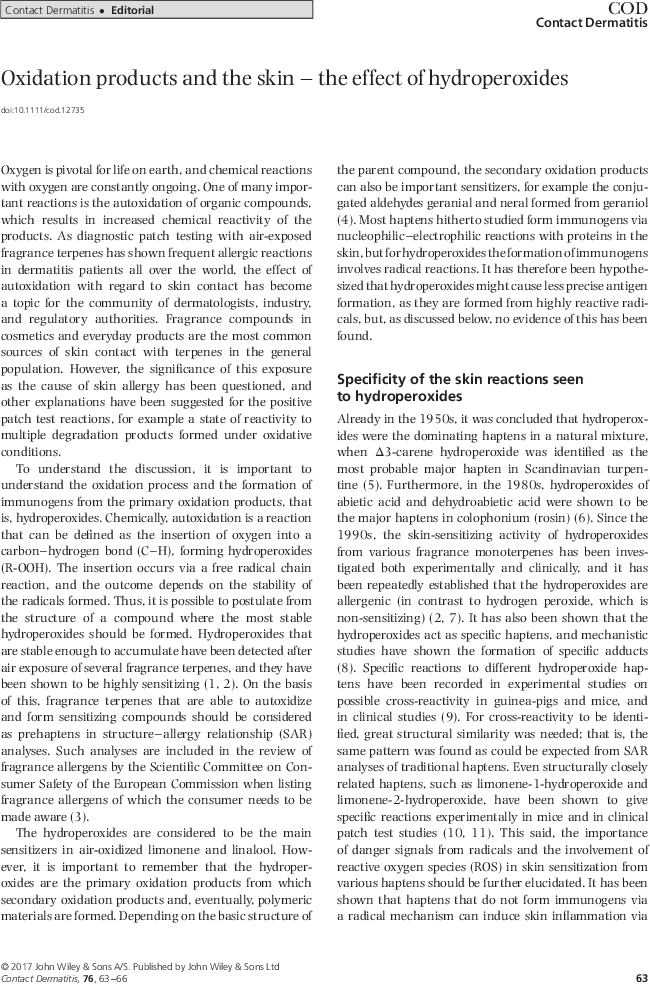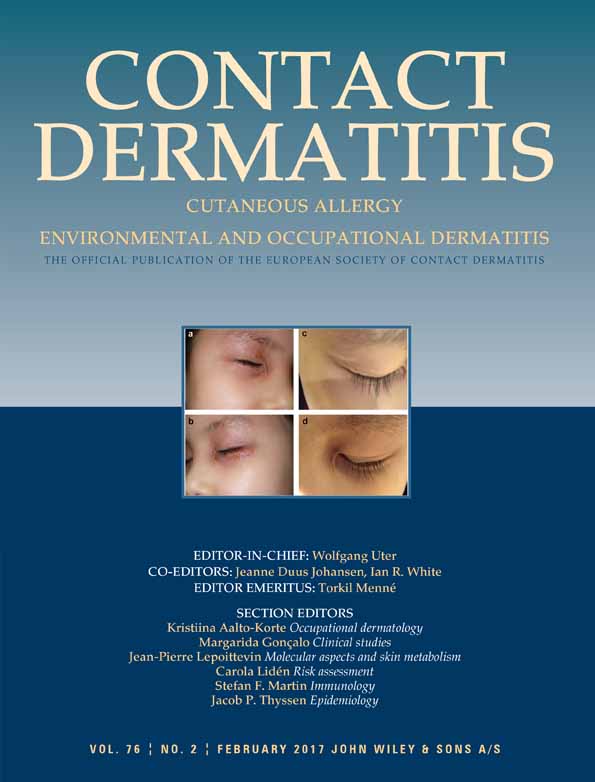Editorial
Oxidation products and the skin – the effect of hydroperoxides
Ann-Therese Karlberg,
Ann-Therese Karlberg
Department of Chemistry and Molecular Biology, Dermatochemistry, University of Gothenburg, SE-412 96 Gothenburg, Sweden
Search for more papers by this authorAnn-Therese Karlberg,
Ann-Therese Karlberg
Department of Chemistry and Molecular Biology, Dermatochemistry, University of Gothenburg, SE-412 96 Gothenburg, Sweden
Search for more papers by this authorFirst published: 17 January 2017

References
- 1Karlberg A T, Bergström M A, Börje A et al. Allergic contact dermatitis – formation, structural requirements, and reactivity of skin sensitizers. Chem Res Toxicol 2008: 21: 53–69.
- 2Bråred Christensson J, Hagvall L, Karlberg A T. Fragrance allergens, overview with a focus on recent developments and understanding of abiotic and biotic activation. Cosmetics 2016: 3: 1–19.
10.3390/cosmetics3020019 Google Scholar
- 3 SCCS. SCCS/1459/11 Opinion on fragrance allergens in cosmetic products. Adopted during the 13th Plenary Meeting, 2012, 2011. Available at: http://ec.europa.eu/health/scientific_committees/consumer_safety/docs/sccs_o_073.pdf (last accessed 22 February 2016).
- 4Hagvall L, Bäcktorp C, Svensson S. Fragrance compound geraniol forms contact allergens on air exposure. Identification and quantification of oxidation products and effect on skin sensitization. Chem Res Toxicol 2007: 20: 807–814.
- 5Hellerström S, Thyresson N, Blohm S G, Widmark G. On the nature of the eczematogenic component of oxidized delta 3-carene. J Invest Dermatol 1955: 24: 217–224.
- 6Karlberg A T. Colophony: rosin in unmodified and modified form. In: Kanerva's Occupational Skin Diseases, 2nd edition, Vol. I, T Rustemeyer, P Elsner, S M John, H I Maibach (eds): Berlin, Heidelberg, Springer-Verlag, 2012: pp. 467–479.
10.1007/978-3-642-02035-3_41 Google Scholar
- 7Karlberg A T, Börje A, Duus Johansen J et al. Activation of non-sensitizing or low-sensitizing fragrance substances into potent sensitizers – prehaptens and prohaptens. Contact Dermatitis 2013: 69: 323–334.
- 8Redeby T, Nilsson U, Altamore T M et al. Specific adducts formed through a radical reaction between peptides and contact allergenic hydroperoxides. Chem Res Toxicol 2010: 23: 203–210.
- 9Bråred Christensson J, Matura M, Bäcktorp C et al. Hydroperoxides form specific antigens in contact allergy. Contact Dermatitis 2006: 55: 230–237.
- 10Bråred Christensson J, Johansson S, Hagvall L et al. Limonene hydroperoxide analogues differ in allergenic activity. Contact Dermatitis 2008: 59: 344–352.
- 11Bråred Christensson J, Hellsén S, Börje A, Karlberg A-T. Limonene hydroperoxide analogues show specific patch test reactions. Contact Dermatitis 2014: 70: 291–299.
- 12Esser P R, Wolfe U, Durr C et al. Contact sensitizers induce skin inflammation via ROS production and hyaluronic acid degradation. PLoS One 2012: 7: e41340.
- 13Bråred Christensson J, Andersen K E, Bruze M et al. Air-oxidized linalool – a frequent cause of fragrance contact allergy. Contact Dermatitis 2012: 67: 247–259.
- 14Bråred Christensson J, Andersen K E, Bruze M et al. An international multicentre study on the allergenic activity of air-oxidized R-limonene. Contact Dermatitis 2013: 68: 214–223.
- 15Audrain H, Kenward C, Lovell C R et al. Allergy to oxidized limonene and linalool is frequent in the UK. Br J Dermatol 2014: 171: 292–297.
- 16Deza G, García-Bravo B, Silvestre JF et al. Contact sensitization to limonene and linalool hydroperoxides in Spain: a GEIDAC prospective study. Contact Dermatitis 2017: 76: 74–80.
- 17Nardelli A, Carbonez A, Drieghe J, Goossens A. Results of patch testing with fragrance mix 1, fragrance mix 2, and their ingredients, and Myroxylon pereirae and colophonium, over a 21-year period. Contact Dermatitis 2013: 68: 307–313.
- 18Bråred Christensson J, Karlberg A T, Andersen K E et al. Oxidized limonene and oxidized linalool – concomitant contact allergy to common fragrance terpenes. Contact Dermatitis 2016: 74: 273–280.
- 19Bennike N H, Lepoittevin J-P, Duus Johansen J. Can contact allergy to p-phenylenediamine explain the high rates of terpene hydroperoxide allergy? – An epidemiological study based on consecutive patch test results. Contact Dermatitis 2017: 76: 67–73.
- 20Rudbäck J, Islam M N, Börje A. Essential oils can contain allergenic hydroperoxides at eliciting levels, regardless of handling and storage. Contact Dermatitis 2015: 73: 253–254.
- 21Bonefeld C M, Nielsen M M, Rubin I M et al. Enhanced sensitization and elicitation responses caused by mixtures of common fragrance allergens. Contact Dermatitis 2011: 65: 336–342.
- 22Madsen J T, Vogel S, Karlberg A T et al. Ethosome formulation of contact allergens may enhance patch test reactions in patients. Contact Dermatitis 2010: 63: 209–214.
- 23Andersch Björkman Y, Hagvall L, Siwmark C et al. Air-oxidized linalool elicits eczema in allergic patients – a repeated open application test study. Contact Dermatitis 2014: 70: 129–138.
- 24Kern S, Dkhil H, Hendarsa P et al. Detection of potentially skin sensitizing hydroperoxides of linalool in fragranced products. Anal Bioanal Chem 2014: 406: 6165–6178.
- 25Elliott J F, Ramzy A, Nilsson U et al. Severe intractable eyelid dermatitis probably caused by exposure to hydroperoxides of linalool in a heavily fragranced shampoo. Contact Dermatitis 2017: 76: 114–115.
- 26 IDEA (International Dialogue for the Evaluation of Allergens) Available at: www.ideaproject.info/.




